How to create a smooth SaaS email onboarding (With full sequence example)
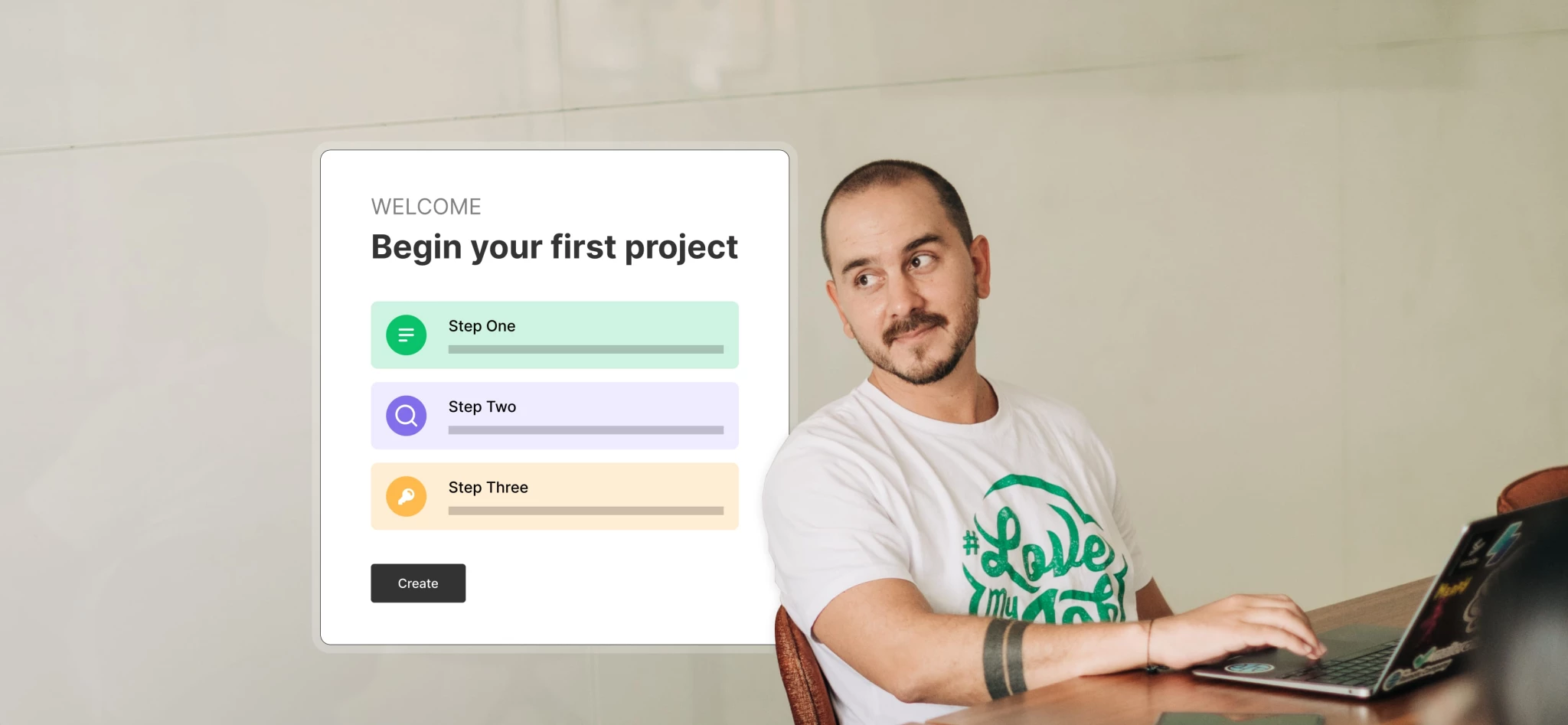 Juan, compliance team
Juan, compliance team
All SaaS tools have a learning curve. Getting people past this early challenge is essential for ensuring new signups keep using your product.
A SaaS email onboarding sequence is one of the most effective tools you can use to ease people through this process. This series of emails should introduce new subscribers to your platform, help them get set up and ensure they can get maximum value from your tool.
In this article, we teamed up with SE Ranking to hear how they think about email onboarding. The SEO tool's email marketing team lead Tetiana Melnychenko goes through email onboarding sequence goals, best practices, and shows the exact emails she uses to keep new signups engaged.
The goals of a SaaS email onboarding sequence
The goal of a SaaS email onboarding sequence is to encourage people who sign up for the tool to see its value. This will reduce customer churn and increase the lifetime value of our customers.
SE Ranking does this by creating a sequence that educates customers about the platform and its features and tells them how to get set up. This helps users realize the full potential of the platform, making them more likely to stick around.
The SaaS email onboarding process
The onboarding email sequence for a SaaS company usually includes anywhere from 3 to 10 emails stretched across a couple of weeks, SE Ranking's is no different.
The exact number of emails customers receive depends on factors like how they interact with the tool and their industry.
Most people typically receive the following content:
Welcome email with general account setup information
Instructions for basic first tasks on the platform
Relevant product tours
Follow-up communication
In between those emails, the user may also receive personalized communication based on the user's activity on the platform.
Pre-onboarding: Segmentation
Before sending any emails, the first step in creating a SaaS onboarding sequence is segmenting users so they receive emails that meet their needs and goals.
The SE Ranking SEO toolset is used by both complete beginners and seasoned professionals. These people come from diverse demographics and have different needs.
Therefore, the main goal of the email onboarding sequence is to serve only information that is useful and relevant to the recipient. To that end, segmenting the recipient list is important.
There isn’t much information to go off at the beginning of a subscription, but one of the main sources of information is the signup poll. It can tell you what type of company the new user has and personalize our emails to fit their specific needs.
Another source is monitoring their first steps on the platform, such as the features they use and how often they access learning resources.
Once you have assessed how factors like industry and product usage are likely to impact retention, you can move on to creating the emails that will help.
SaaS email onboarding sequence example
What you’ll see here are the standard user onboarding emails that most SE Ranking clients see upon registration and the reasons for sending these emails.
This will help you understand the internal logic of the onboarding sequence and apply it to your business.
Email 1: Welcome new signups with an email
The first email in any onboarding sequence is the welcome email. Here is how it looks for SE Ranking clients.

Subject line: Welcome to SE Ranking! An all-in-one SEO platform for agencies
Email goal: Share general information about the platform, credentials, first steps to take, and useful resources.
Timing: As soon as the user signs up
Apart from welcoming the user to the platform, this email accomplishes a few key goals.
First, it offers an introductory video that is tailored to the audience, in this case, for agencies. This element of personalization is based on the industry that new customers mark in the poll after registration.
Then, it showcases the six first steps that customers should do with the company’s toolkit and provides links to study each in more detail.
At the bottom of this email, we provide four links to learning resources that can be used by people with different preferences: blog, help center, YouTube channel, and Facebook community.
The first email typically has the highest open rate out of the entire sequence, so make sure to include all the important essentials in it.
This email also has 2 effective CTA buttons. One at the top of the email for people who want a fast way to start using the platform after getting a reminder about it, and one at the bottom with the text that prompts users to the expected action—creating their first project.
Email 2: Encourage new signups to take their first step
One of the core functionalities of SE Ranking is monitoring the SEO performance of a website. The sooner a user adds their website, the faster they can receive performance data. That’s why it’s the first action they should take on the platform.
This optional email prompts them to do that. It’s based on user behavior tracking and will trigger the new customer to create a project within two business days if they haven't already done so.
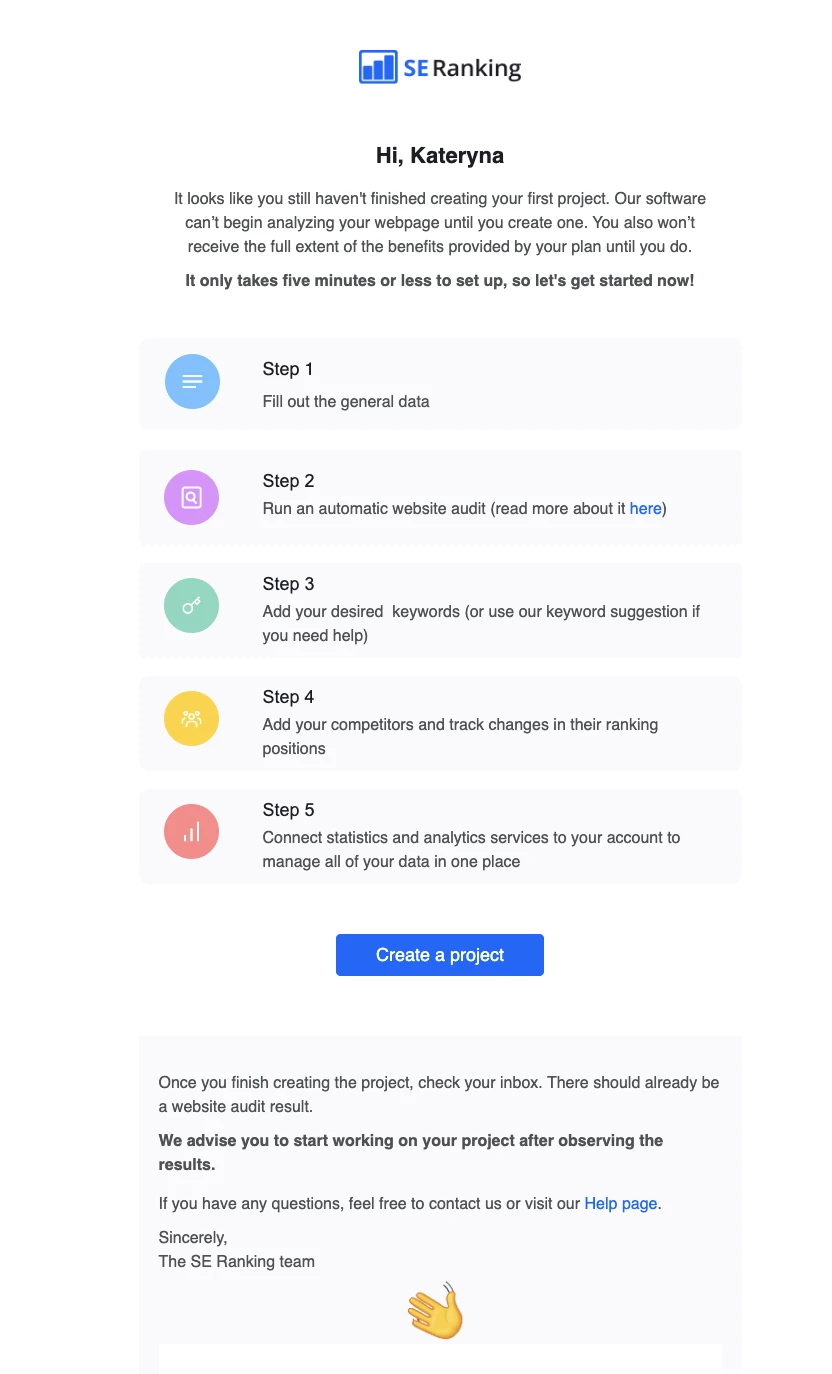
Subject line: Add your 1st project to start a new SEO journey
Goal of the email: Show a clear path to making the first step on the platform.
Email goal: If a user doesn’t start using the tool in two business days.
As you can see, this email is pretty straightforward—it presents a step-by-step guide to doing the first and most important thing on the platform. It also links additional resources on the steps that might be too complex to explain in a few sentences.
Then, it provides a CTA button that leads to the dashboard, where the user can go through those steps.
The key here is serving this email to the right people. Since it only triggers when a user doesn’t go through this process, it won’t annoy others who did and will serve as a reminder and guide to people who haven’t used the platform yet.
Email 3: Highlight your most important tools
This email presents one of the tools offered by the platform, in this case, the SE Ranking Competitor Checker. This is one of the core features that help with SEO planning and research, so it makes sense to showcase it in the SaaS onboarding email sequence.
Essentially, this email serves as a short demo of the tool.

Subject line: Make your competitor’s strategy work for you
Goal of the email: Showcase your most popular and useful tools
Timing: Either after a few days or based on product usage
The email copy explains what the tool can do, presents a step-by-step guide on how to use it, and leaves a CTA button that leads to it so users can try it out immediately.
After that, there are more precise instructions for using it, with screenshots and a link to a blog post that explains the tool in greater detail.
This way, we give users three main ways to experience this tool: experimentation, short guide, and in-depth guide.
Emails that present tools can either be served to all users or personalized based on user behavior. You can send an email like this to users who haven’t used the tool shortly after registration.
Email 4: Show your tool’s impact with case studies
The full value of complex SaaS tools can be hard to grasp, especially for beginners. It’s hard to imagine how all the elements can come together when you’ve never used a tool like this before.
That’s why sharing case studies in the onboarding process is essential to give new users an overview of the possibilities that are open to them.
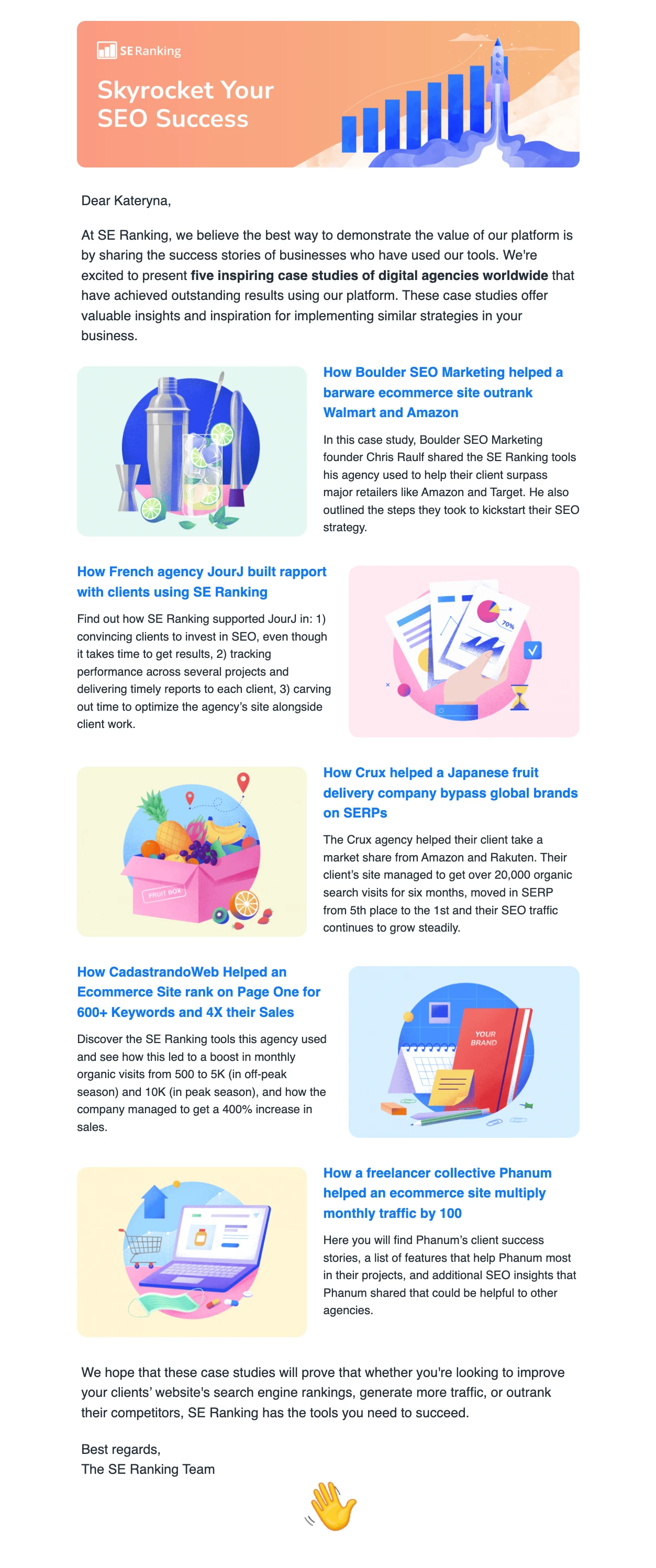
Subject line: Case Studies: How SE Ranking helped agencies achieve SEO success
Goal of the email: Share practical use cases and provide social proof
Timing: Within a week of registration
This email links to five case studies of SE Ranking clients that achieved success and a short introduction to each of them that motivates readers to click on the link and learn more.
This email is personalized, and the selected case studies are all about digital agencies just like the supposed client.
Since these types of onboarding emails promote content, you’ll have to work with your content marketing team to make it effective. The case studies should be well written, focus on details important to the customer, and explore the use of the tools you provide.
Email 5: Target your audience’s pain points and show how your product helps
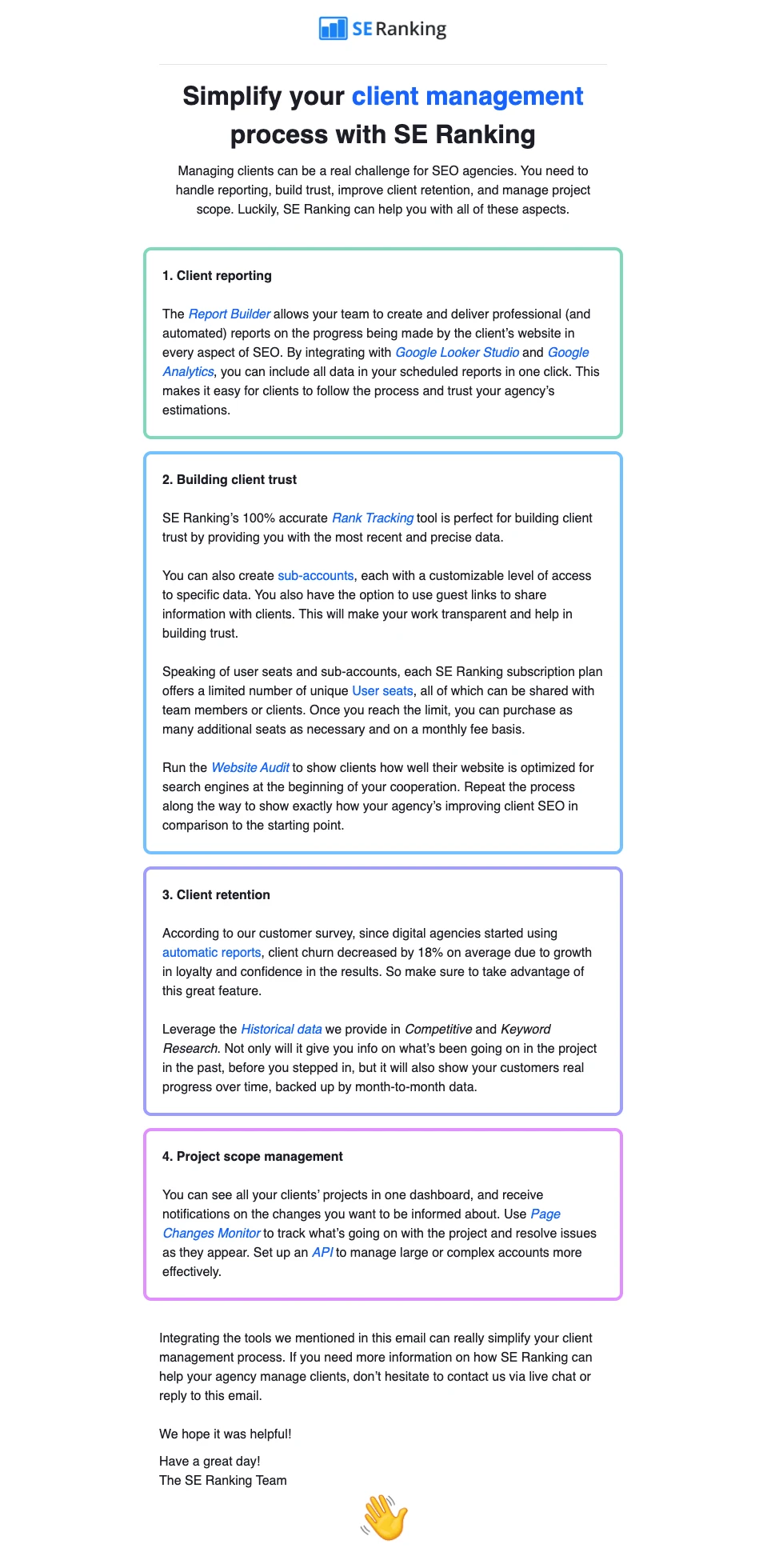
This email doubles down on the previous one by showing ways to solve the most common problems of the specific type of business with our tools.
Subject line: Client management made easy with SE Ranking
Goal of the email: Show how users can solve most common problems with your product
Timing: Within the first two weeks of registration
The email explains four types of pain points digital agencies face, shows ways to solve them with our tools, and provides links to further reading where we explain solutions in more depth.
The selection of issues covered is based on an internal customer survey and differs for all major types of businesses that work with us.
If your SaaS company offers multiple tools that might be industry-specific in their application, you’ll have to understand what tools are most useful to each customer segment to serve this email well. Use internal surveys and product usage statistics to provide the right information to the right customers.
Email 6: Share useful materials suitable to each customer segment
The last part of this onboarding email sequence expands on the previous two emails and introduces educational resources with a few of the most appropriate assets.
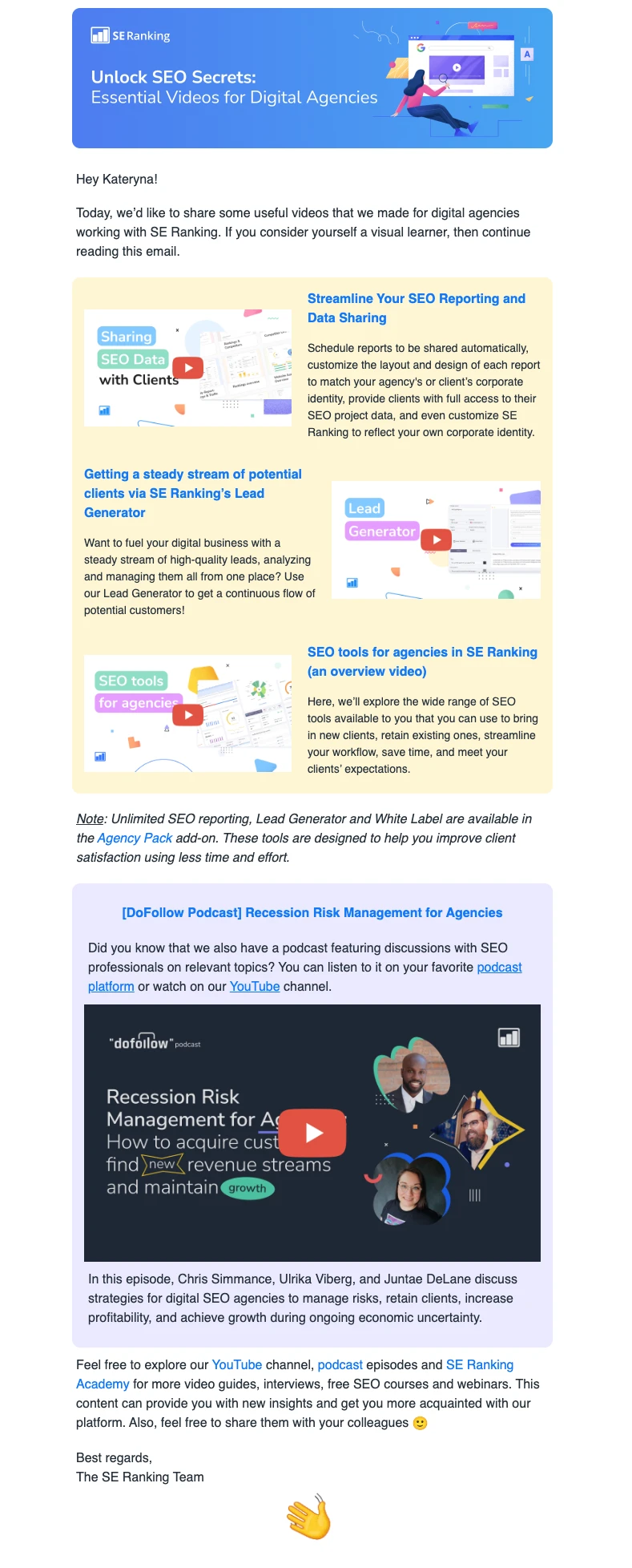
Subject line: Level up your agency's SEO game: must-see videos inside
Goal of the email: Introduce users to educational content by showcasing actionable resources in different formats.
Timing: Within the first two weeks of registration
In our email marketing calendar, we have dozens of emails with educational resources that can help customers succeed after the onboarding sequence ends.
This last email in our onboarding sequence serves to introduce them to the possibility of learning and shows them the available resources in an engaging way.
The content suggestions are based on what this segment of the customer base needs and are updated once a more suitable content piece comes out.
The email suggests three YouTube videos and a podcast to start the exploration of educational content and has links for all educational media for those who want to explore on their own.
Despite being the last email in the sequence, it's an important email because customer education increases product usage. Customers who are trained to use your tools will do so more effectively, deliver more value, and ultimately stay longer, improving your retention rate and ARR.
Effective SaaS onboarding email best practices
The final composition of your onboarding email sequence and its content depends on a lot of factors, most of them tied to what type of product you’re promoting and to whom.
However, there are a few best practices that you should incorporate, no matter what your email sequence looks like.
Segmentation
Segmentation is one of the general email marketing best practices, and you should include it in your onboarding emails as well.
The easiest way to segment the email list for onboarding SaaS clients is to run a small questionnaire upon registration to discover information that could be useful for segmentation.
For example:
The industry they’re in
The features they plan on using
The size of their company
Their role in the company is
Based on the answers to those questions, you’ll be able to serve appropriate content from the very beginning.
Personalization
The logical conclusion to segmentation is personalizing the onboarding emails. Apart from serving different educational content based on poll answers, you should include the customer’s name and use their native language in communications if possible.
You can easily add personalized content to emails using custom field tags. These tags will add the content in the custom field to the email in the relevant place. For example, using the tag {$name} will add data from the name field, and using {$location} will add data from the location.
What's more, you can create any custom field you want and add that to your email. You just need to use forms or surveys to collect the information in the first place.
Behavior-based automation
Another form of personalization that can enhance your onboarding email sequence is automating certain onboarding communications based on user behavior.
An example of that onboarding practice from SE Ranking would be tracking whether the user has logged in or not, and if they haven’t logged in, sending them a reminder email offering to see a demo from the sales team.
The goal here is to focus on customers who might not have used the toolkit yet and haven’t learned much about it and introduce them to the capabilities of the platform.
We also track whether the user has performed actions that we expect them to or whether their trial is expiring. This can serve as a reason for a reactivation email prompting the user to go on with the next action and providing resources to do so.
A/B testing and experimentation
As with any email campaign, testing different approaches is a must. You never know whether your first ideas on what different customers might want to see in the onboarding sequence are correct.
Create several ideas for onboarding email content and sequence options and test them against each other. Keep the tests confined within segments to see better results.
User feedback and survey integration
A/B testing data is useful, but having access to qualitative data on email performance to complete the picture is even better. One way to get it is to run a survey after the onboarding emails and ask your new customers whether it was useful to them.
A survey like this can show you how your customers perceive the onboarding process and give you insight into what you need to change.
But don’t rush into action after one customer suggests you include or discard one of the resources from the emails as it might be a matter of segmentation and not a universal problem.
Performance analytics
Finally, you should analyze the overall performance of the email campaign. These are the metrics you can track to understand how it performs.
Open rate
Click rate
Bounce rate
Specific elements that people click on
Track these metrics across the whole onboarding email campaign and within specific segments of the email list. This will give you a full picture of email performance and provide insights into what can be improved.
The final judge of whether the onboarding sequence of emails is effective is the churn rate, especially in the first couple of months, and metrics that indicate how well customers are familiar with the platform.
Start your customers’ journeys the right way
Now you know more about building onboarding email sequences for SaaS. Do a bit of research on your customer expectations about onboarding, grab one of Mailerlite's email templates, and create an experience that will empower your customers for success.
Monitor the onboarding campaign and learn how you can serve them even better with analytical tools and surveys.
Power your SaaS with email marketing
Sign up for MailerLite to build your SaaS onboarding experience. Access personalization, segmentation, multi-step automation and more to create experiences that turn new signups into long-term users. Start with a 14-day of our advanced features.

I’m Tetiana, the Email Marketing Team Lead at SE Ranking. Over the last six years, I have developed about 1000 successful email campaigns. I’m constantly seeking ways to increase engagement, conversions, and revenue via email. I find inspiration in traveling and visiting music festivals.



